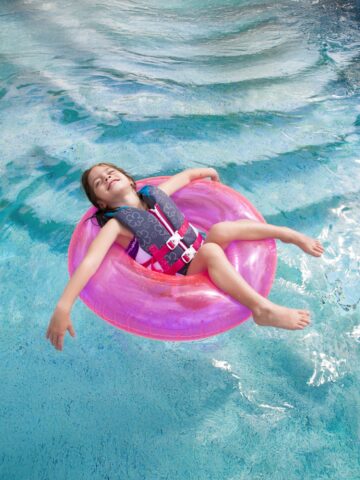If you’re from Orange County or planning a family vacation, you might be heading to the beach this summer with family or friends. A day at the beach is a great way to cool off in the water and have some fun, but it’s important to keep some safety tips in mind to optimize your day.
Here, our experts offer tips on sunscreen, water safety, jellyfish stings and staying hydrated.
Make sure to wear sunscreen
Every child needs sun protection. The American Academy of Dermatology (AAD) recommends that all kids — regardless of their skin tone — wear sunscreen with an SPF of 30 or higher when spending any length of time outdoors.
Babies younger than 6 months old should be kept out of the sun. When going outside, dress your baby in lightweight clothes that cover arms and legs — and don’t forget a hat with a brim. If you can’t avoid the sun, you can use a small amount of sunscreen on your baby’s exposed skin, like the hands and face.
Be a good role model too. Consistently wearing sunscreen with SPF 30 or greater and limiting your sun exposure will reduce your risk of skin damage and teach your kids good sun sense. Make sure you reapply often, especially after being the water or toweling off.
What to look for when choosing a sunscreen
When choosing sunscreen, there are three important things to look for. Check the label for a sunscreen that:
- Has an SPF (sun protection factor) of 30 or higher.
- Protects against both UVA and UVB rays (considered a “broad-spectrum” sunscreen).
- Is water-resistant (protects kids while in the water for 40 to 80 minutes).
Sunscreens are available as creams, gels, sprays and sticks. Creams are best for dry skin areas, sticks help around the eye area, and gels are good for areas with hair (like the scalp). Sunscreen sprays can make it hard to know if you’ve applied enough, and there’s a chance that kids could breathe in the fumes. Some sprays are also flammable, so you need to avoid sparks or flames when using them.
A CHOC clinical pharmacist explains the ingredients in sunscreen.
How, when, and where to use sunscreen
Every child needs sun protection. The American Academy of Dermatology (AAD) recommends that all kids — regardless of their skin tone — wear sunscreen with an SPF of 30 or higher.
Keep babies younger than 6 months old out of the sun. When going outside, dress your baby in lightweight clothes that cover arms and legs — and don’t forget a hat with a brim. If you can’t avoid the sun, you can use a small amount of sunscreen on your baby’s exposed skin, like the hands and face.
Be a good role model too. Consistently wearing sunscreen with SPF 30 or greater and limiting your sun exposure will reduce your risk of skin damage and teach your kids good sun sense. Reapply often, especially after being in the water and toweling off.
For sunscreen to do its job, it must be used correctly:
- Apply sunscreen whenever your kids will be in the sun. For best results, apply it about 15 to 30 minutes before kids go outside.
- Don’t forget about ears, hands, feet, shoulders and behind the neck. Lift up bathing suit straps and apply sunscreen underneath them (in case the straps shift as a child moves). Protect lips with an SPF 30 lip balm.
- Apply sunscreen generously. Dermatologists recommend using 1 ounce (enough to fill a shot glass or plastic medicine cup) to cover the exposed areas of the body. Another trick is to use the “teaspoon rule.” Use 9 teaspoons of sunscreen for the whole body: 1 teaspoon for the face and neck, 1 teaspoon for the front of the torso and 1 for the back of the torso, 1 teaspoon for each arm, and 2 teaspoons for each leg.
- Reapply sunscreen often, about every 2 hours. Reapply after a child has been sweating or swimming.
- Apply a water-resistant sunscreen if kids will be around water or swimming. Water reflects and intensifies the sun’s rays, so kids need protection that lasts. Water-resistant sunscreens may last up to 80 minutes in the water, and some are also sweat-resistant. But regardless of the water-resistant label, be sure to reapply sunscreen when kids come out of the water.
Don’t worry about making a bottle of sunscreen last. Stock up, and throw out any sunscreen that is past its expiration date or that you have had for 3 years or longer.
Learn more about sun safety and skin protection from CHOC experts.
Practice caution in changing beach and water conditions
Because ocean waves can quickly change, it’s important to recognize that kids might need to practice different precautions at the beach than in a swimming pool.
Make sure to practice these water safety tips at the beach:
- Don’t let kids swim without adult supervision, preferably where a lifeguard is on duty.
- They shouldn’t swim close to piers or pilings because sudden water movements may push swimmers into them.
- The beach has special dangers like currents and tides. Look for posted signs about rip currents, jellyfish warnings, surfing restrictions, and other hazards. Also, ask the lifeguard about the water conditions.
- Don’t allow kids to swim in large waves or undertows. Tell them never to stand with their back to the water because a sudden wave can knock them over.
- Teach kids that if they’re caught in a rip current or undertow, they should swim parallel to the shore or should tread water and call for a lifeguard’s help.
- In bad weather, they should get out of the water right away. If there’s lightning, the lifeguards will close the beach.
Water temperature is also important. Enter the water slowly and make sure it feels comfortable for you and your kids. A temperature below 70°F (20°C) is cold for most swimmers. Recommended water temperatures vary depending on the activity and a swimmer’s age.
In general, 82°F–86°F (28°C–30°C) is comfortable for recreational swimming for children.
Babies are more comfortable when the water is on the warmer side of this temperature range.
Traveling to a beach this summer? CHOC experts offer top traveling tips for families.
Stay energized and hydrated
With just a bit of pre-planning, you can ensure that your kids will have the hydration and nutrients they need to spend an active day at the beach. Avoid the hot and long lines at the beach food stand, which typically serves highly-processed foods that are overpriced and can leave you feeling fatigued and dehydrated.
Instead, pack healthy snacks and focus on rehydrating with water to combat the hot sun.
Get beach-friendly, nutritious snack and meal recipes for your next trip.
Watch out for jellyfish
Jellyfish have been around for millions of years and live in oceans all over the world. There are many different types of jellyfish — some look like small, clear blobs, while others are bigger and more colorful with tentacles hanging beneath them.
Jellyfish sting their prey with their tentacles, releasing a venom that paralyzes their targets. Jellyfish don’t go after humans, but someone who swims up against or touches one — or even steps on a dead one — can be stung all the same.
While jellyfish stings are painful, most are not emergencies. Expect pain, red marks, itching, numbness, or tingling with a typical sting.
But stings from some types of jellyfish — such as the box jellyfish (also called sea wasp) — are very dangerous, and can even be deadly. These jellyfish are most often found in Australia, the Philippines, the Indian Ocean and the central Pacific Ocean.
CHOC offers four water safety tips for your summer.
How are jellyfish stings treated?
Jellyfish stings leave thousands of very tiny stingers called nematocysts in the skin. These stingers can continue to release (or “fire”) jellyfish venom (poison) into the body. Treatment can vary based on the type of jellyfish most common in the area.
Often, it’s best to rinse a sting with vinegar. Vinegar is a weak acid that might keep the stingers from firing for some kinds of stings (especially from dangerous types like box jellyfish).
Do not rinse with fresh water (like tap or bottled water) because that can make more stingers fire. Rinsing a sting with seawater may prevent stingers from releasing more venom.
Also, do not scrape off any stingers still in the skin. This used to be recommended but now is thought to make stings worse.
To deal with a sting:
- Remove your child from the water.
- Rinse the area with vinegar. (Keep a small plastic bottle of vinegar in your beach bag, just in case.)
- Don’t rub the area, which can make things worse.
- Use tweezers to pluck away any tentacles still on the skin. Do not scrape the area with a credit card or other stiff card.
- A hot (but not scalding) shower or soak may help lessen pain.
- Check in with your health care professional to see if pain relievers might help your child feel better.
Call an ambulance right away if someone has been stung and:
- Has trouble breathing or swallowing.
- Has a swollen tongue or lips, or has a change in voice.
- Has bad pain or feels generally unwell.
- Is nauseated or vomiting.
- Is dizzy or has a headache.
- Has muscle spasms.
- Has stings over a large part of the body.
- The sting is in the eye or mouth.
- Might have been stung by a very dangerous jellyfish.
Can jellyfish stings be prevented?
Beaches with lifeguards are more likely to warn visitors about jellyfish. Look for a sign or warning flag (some beaches fly a purple warning flag when there’s “dangerous marine life” in the water). Double check to make sure that you’ve got a small container of vinegar and a pair of tweezers in your beach bag.
Get more expert health advice delivered to your inbox monthly by subscribing to the KidsHealth newsletter here.
Get more safety and injury prevention tips from CHOC experts
More children are affected by injuries than all other childhood illnesses and diseases combined. Most of these injuries are predictable and preventable. Here’s how to keep your child safe.





